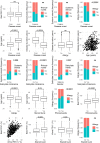Prevalence and characterization of severe asthma in Hungary
- PMID: 32518278
- PMCID: PMC7283249
- DOI: 10.1038/s41598-020-66445-4
Prevalence and characterization of severe asthma in Hungary
Abstract
Background: Severe asthma (SA) database was established in Hungary to estimate the prevalence of SA and to define and analyze clinical phenotypes of the patients.
Methods: SA questionnaires were sent out to 143 public pulmonary dispensaries specialized for diagnosing and caring pulmonary patients. Data of 520 SA patients were evaluated.
Results: The prevalence of SA within the asthmatic population in Hungary was 0.89%. The mean age of patients were 56.4 ± 13.4 years, SA were more frequent in females (64%), the prevalence of allergy was 56.6%, 72.1% of patients had persistent airflow limitation (FEV1 < 80%), 37.9% severe airway obstruction (FEV1 ≤ 60%), 33.6% required systemic corticosteroid maintenance therapy, 21.5% had salicylate intolerance and 43.2% rhinosinusitis. A Bayesian dependency network was calculated which revealed several interdependencies between the characteristics. E.g. there was a strong association between salicylate intolerance and rhinosinusitis, more patients received regular systemic corticosteroid treatment who had salicylate intolerance and the proportion of salicylate intolerance was significantly higher in females.
Conclusion: The prevalence of SA was determined in Hungary which was lower than in other studies. Using a Bayesian-based network analysis several interdependencies were revealed between patient characteristics.
Conflict of interest statement
The authors declare no competing interests.
Figures



References
-
- ENFUMOSA Study Group. The ENFUMOSA cross-sectional European multicentre study of the clinical phenotype of chronic severe asthma. European Network for Understanding Mechanisms of Severe Asthma. Eur. Respir. J. 2003;22:470–7. - PubMed

